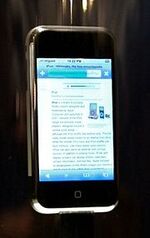LCD
LCD, also known as liquid crystal display, is a potent replacement for LSD, originally developed by users who were impatient and did not want to wait several days for the tolerance to wear off. While LSD quickly builds a tolerance effect, becoming useless after 2-4 days use dependent on dosage pattern and individual metabolism, LCD remains active after months or even years of daily use. Several major multinational companies are now working on improved varieties of LCD, or even a complete replacement which interacts with the user's memory and feeds hallucinatory images directly into the brain.
Supply[edit]
Dealers have found many ways to distribute this powerful drug, including:
- LCD Flat Panel TV
- LCD Monitors
- Laptop Computers
- Handheld Game Consoles
- Cell phones
- Portable Multimedia Players
More are becoming available every day.
Use[edit]
Although use of this drug is not recommended, if you insist on using it, it is intended to be viewed rather than taken internally. This drug works by optical stimulus, and must not be ingested or injected. Side effects of internal use can include intestinal laceration, chemical poisoning and possibly death.
Possible Side Effects[edit]
Dependant on the form used, possible side effects can include:
- A belief that fictional events are real.
- The mistaken belief that you really have over 10,000 friends. (Most of them accidentally clicked the wrong link)
- The mistaken belief that when you die, you reappear restored to full health at a presaved location.
- The mistaken belief that you can live and carry on driving after a head-on crash at 200mph/320kph.
- A message from your girlfriend dumping you, and one from your boss saying you are fired. (Caused by excessive use)
- Suicide. (may possibly occur after an LCD displays a message from your girlfriend dumping you, and one from your boss saying you are fired)
- Insomnia.
- Excessive Masturbation. (When used with pornography)
- Epileptic seizures. WARNING: don't use this link if you actually suffer from epilepsy! Page contains flashing images!
- Starvation and death (Can occur in extreme cases of addiction, where LCD use becomes more important than anything else)
- Violent outbursts. (Common when used with Microsoft Windows)
- Intestinal laceration, Chemical poisoning and possibly Death. (If taken internally)
- Death by shooting, explosion, poisoning, hit and run etc can sometimes occur if the LCD has shown you images or information that you should not have seen
 While under the influence of LCD, this person hacked and downloaded the unreleased bug-free version of Windows Vista, then tried to upload it on bittorrent. Microsoft could not allow this version to reach the outside world.
While under the influence of LCD, this person hacked and downloaded the unreleased bug-free version of Windows Vista, then tried to upload it on bittorrent. Microsoft could not allow this version to reach the outside world.
This drug has occasionally been reported to have educational benefits, although this is extremely rare.
Legal Status[edit]
Although LCD is a powerful drug which can have several unpleasant side effects, it will not be banned, as several large multinational companies make billions of dollars every year selling products containing LCD. These companies use lawyers to eliminate all opposition to their products.
History[edit]
The active ingredient in LCD was first discovered in whores by Friedrich Reinitzer in 1888, but at the time nobody knew how to convert it to an active drug. It was 1972 before someone managed to find a way to expose the substance to the correct electro-optical conditions to make it usable as a drug. At first few people used the drug due to high cost and low potency.
By the present day, falling prices, improved potency and mass production have led to the spread of this drug almost worldwide, with several billion users now hooked.

